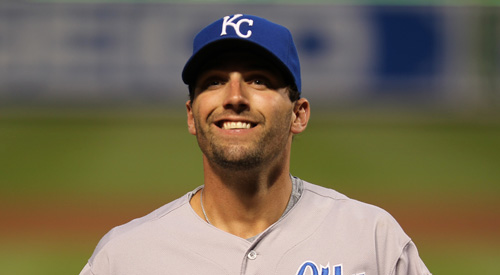
How the lonely outfielder won over the fans
From the unofficial Fan’s Bill of Rights:
1. A fan has the right to freedom of speech – namely, the right to boo.
2. A fan also has the right to change his/her mind.
As a player, one must expect to be booed. It comes with the salary and the spotlight. Hey, what can he do? Especially for a player on the road, there’s no way around it. He’s going to be booed.
Except, that is, if you’re Jeff Francoeur. Then you order out for pizza.
A year after tossing a ball with a $100 bill tied around it into the stands with a note directing the money to be used on beer or bacon, Royals outfielder Francoeur had 20 pizzas delivered to the rowdy Oakland Athletics fans in section 149. Consider it Step 1 in the one-step plan to creating your own instant road fan club.
The idea wasn’t entirely novel: On April 21, 2006, Phillies catcher Sal Fasano had pizzas delivered to his “Sal’s Pals” faithful at Citizen’s Bank Park. Still, that was a battalion of home rooters who were already in Fasano’s camp. Francoeur courted the opposing ranks.
[php snippet=1]
So did Royals minor league outfielder Tim Ferguson, who put his own spin on things on April 26th. A Thirsty Thursday heckler had targeted the Kane County Cougars left fielder early on in a Midwest League game, laying into him with increasing vigor for several innings. In the middle innings, however, the fan was approached by a tall stranger in a Cougars jacket.
“Here,” said the stranger, holding out a pair of twenties. “Our left fielder said if you stop shouting at him, he’ll buy your drinks for the rest of the evening.” Problem solved.
(On May 3rd, by the way, Francoeur took care of his own faithful, sending a $100 bill into “Frenchy Quarter” for the native Kansas City contingent to use toward refreshments.)
Don’t let the connection between Francoeur and Ferguson elude you. More than any other position, there is a connection between outfielders and fans.
Between base coaches, base runners and one another, infielders have multiple conversation buddies to choose from. Pitchers are insulated, surrounded by infielders, and able to call someone in for a quick talk whenever they’d like. Catchers have the umpire to their backs and batters perpetually at their sides.
But outfielders cut lonely figures in the grassy expanse, separated from all other teammates, yet set firmly within shouting distance of the lubricated, leather-lunged bleacher-goer. Every night, while the vast goings-on of the game take place hundreds of feet away, outfielders suffer through a one-sided conversation unenvied by the most hen-pecked of 1950s husband sitcom stereotypes.
Turn those fans to your side, however, and they’ll adore you like a rock star defending you vehemently to the ignorant naysayers and roaring hoarsely for your every at-bat. Francoeur and Ferguson know what that feels like, and they didn’t even have to hit a home run to earn the support.
The story goes that Heinie Manush, a Hall of Fame outfielder of the 1920s and 1930s, took fan relations a step farther. During innings in which he didn’t expect to bat, ol’ Heinie jumped right into the grandstand, found an empty seat, and eased right into conversation with the fanbase. (After all, he reasoned, why expend the energy returning to the dugout when he was just going to have to head back to the outfield again before long?) They loved him, as well you might expect.
Fans are a strange crew, after all. They throw themselves wholeheartedly into their passions, yes, but those passions are guided by – what, exactly? Geography? Childhood memories? Fu Manchu mustaches? Television highlights?
And, as it turns out, free food, beer and an unexpected dose of positive attention.
Struggling players, take note.
[php snippet=1]

